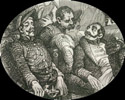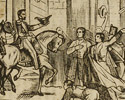19th Century´s militar history in the Basque Country
BILBAO. 1835-VI and 1836-X/XI
 The Carlists urgently needed to take a city for financial and diplomatic reasons, so Zumalacárregui , following his successful campaign in Gipuzkoa and Bizkaia, was put in charge of the mission to take Bilbao. The blockade began on the 10th of June 1835. On the 12th, the city was given the option of surrender, with the threat of a heavy attack if it did not. The Count of Mirasol, the then leader of the soldiers in Bilbao, replied to Zumalacárregui's offer with a firm "No". The bombardment began on the 14th, but the city's batteries were stronger than the Carlists and paradoxically more damage was inflicted in the lines of the besieger than the besieged.
The Carlists urgently needed to take a city for financial and diplomatic reasons, so Zumalacárregui , following his successful campaign in Gipuzkoa and Bizkaia, was put in charge of the mission to take Bilbao. The blockade began on the 10th of June 1835. On the 12th, the city was given the option of surrender, with the threat of a heavy attack if it did not. The Count of Mirasol, the then leader of the soldiers in Bilbao, replied to Zumalacárregui's offer with a firm "No". The bombardment began on the 14th, but the city's batteries were stronger than the Carlists and paradoxically more damage was inflicted in the lines of the besieger than the besieged.
Zumalacárregui was injured in the knee during the siege of the Palacio de Begoña on the 15th and was obliged to transfer the command to Eraso. The irreplaceable Carlist leader died as a result of his injury in Zegama on the 24th. The bombardment of Bilbao continued after his death.
 Zumalacárregui had ordered his men not to attack the resident areas of the city until they had taken the bastions surrounding them. Eraso, however, ordered the bombing of the city centre on the 16th. In the meantime, the people of Bilbao waited for reinforcements from San Sebastián and Santander to raise the siege.
Zumalacárregui had ordered his men not to attack the resident areas of the city until they had taken the bastions surrounding them. Eraso, however, ordered the bombing of the city centre on the 16th. In the meantime, the people of Bilbao waited for reinforcements from San Sebastián and Santander to raise the siege.
 The Liberals tried to enter Bilbao via Portugalete on the 18th and 24th, but the Carlists kept up the siege and intensified the bombardments, which had already hit houses, churches and hospitals. Don Carlos visited the site on the 26th to assess the situation. The bombardment of Bilbao continued for a further four days until the Carlists were forced to raise the siege on the 1st of July. The troops of generals Latre, Espartero and La Hera, more numerous than those of Don Carlos, had managed to enter Bilbao.
The Liberals tried to enter Bilbao via Portugalete on the 18th and 24th, but the Carlists kept up the siege and intensified the bombardments, which had already hit houses, churches and hospitals. Don Carlos visited the site on the 26th to assess the situation. The bombardment of Bilbao continued for a further four days until the Carlists were forced to raise the siege on the 1st of July. The troops of generals Latre, Espartero and La Hera, more numerous than those of Don Carlos, had managed to enter Bilbao.
The first siege of Bilbao ended with 31 dead, 130 wounded and 11 prisoners in the city. The Carlist casualties are not known, but the loss of Zumalacárregui was a decisive blow.
The second siege of Bilbao began on the 23rd of October of the following year. The failure of the first attack had forced the Carlists to remove their artillery, but they returned to besiege the city again on the 4th of October under the command of General Egia. This second siege lasted over a month and a half, and ended with the Battle of Luchana on Christmas Eve. As with the first siege, the artillery used by the Liberals to defend Bilbao was more powerful than the Carlist artillery . Although the second siege was much more severe for the defenders and inhabitants of Bilbao, with 250 dead and almost 2,000 wounded, this new defeat for the Carlists showed them that they were unable to take the city. Bilbao became the icon of the Basque Liberals.

